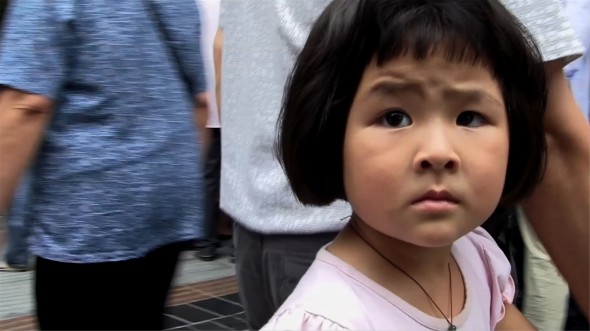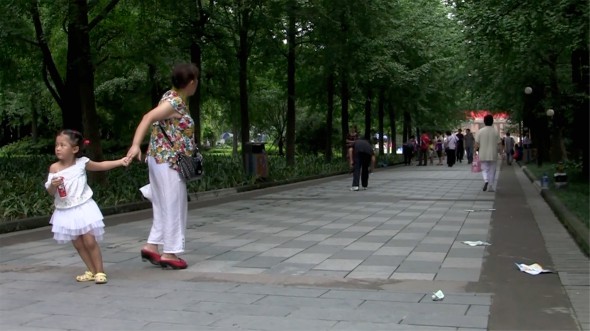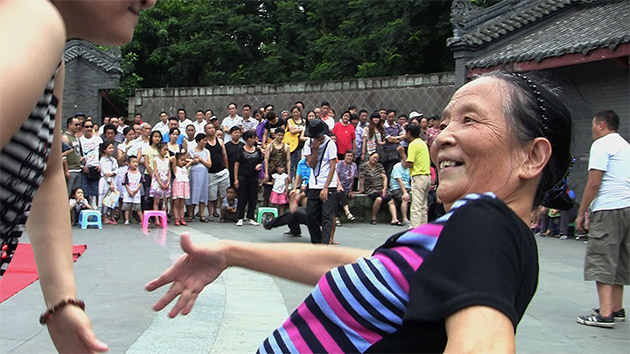Finding a New Perspective on Contemporary China in an Unbroken, 78-Minute Take
People’s Park is a film like no other. As far as I know, it’s the first feature-length documentary shot in a single take, although Alexander Sokurov’s Russian Ark is a fictional precursor. Directors Libbie D. Cohn and J. P. Sniadecki shot a 78-minute take through a park in Chengdu, China, filming from a camera held by Cohn as she sat in a wheelchair pushed by Sniadecki. People’s Park has the dynamic shadings of a narrative film, and a hypnotic quality develops as Cohn and Sniadecki take in the amateur dancers and musicians who populate the park, as well as its empty spaces. Chinese documentary has experienced a boom in recent years; although Cohn and Sniadecki are Americans, their film exposes a side of the country lost in news reports about its rising economy.
StudioDaily: Beyond what we can see in the film, how did people in the park react to your presence?
Cohn: The dancers in the last scene are the people we got to know best. They were the first we met when J.P, and I visited the park. We spent about three hours dancing and hanging out with them. At the start of each day, we would go visit them, drop off our stuff and then film other parts of our park. We had dinner with them and got to know them very well outside the park context. As far as people we didn’t have deeper relationships with, the film encompasses the majority of reactions and responses we had. When we weren’t hanging out with the dancers, we were filming. You see what we saw.
StudioDaily: It’s notable how often people return the gaze of the camera.
Cohn: Yes, partially it’s a result of us being visibly foreigners. More so, it was a matter of our technological get-up. We filmed with me sitting in a wheelchair, holding the camera, and J. P. pushing me at a snail’s pace. So it was a strained assembly of technology, movement and two foreigners. People looked at us because we looked alien. Some people, like the dancers and karaoke singers, grew accustomed to seeing us day after day. But other people, who were parkgoers that might come once a week or once a month, just as likely hadn’t seen us before
StudioDaily: What kind of camera did you use?
Cohn: A Vixia HF S21. It’s a small prosumer Canon model.
StudioDaily: You manage to get a real elegance and control out of it that’s not quite what I would’ve expected from the production’s circumstances.
Cohn: We spent a lot of time thinking about how to keep it from looking bumpy. We didn’t want that to be a distraction. So we tried a hand stabilizer. That didn’t work as well as a wheelchair. We looked into Steadicam, but decided not to go with it because it would introduce a third element into the mix. The shoot was almost like a performance piece. It takes practice and concentration to do the single shot. Having a Steadicam operator, J.P. and me take this walk through the park [together] would’ve led to a different film. The other reason was budgetary constraints. In the end, my arms stabilized it on the wheelchair. We did some stabilization in post-production as well.
StudioDaily: Was it important for you to work with a full co-director rather than just a cinematographer?
Cohn: Very much so, from conception to our ideas about the sound. Both of us have long histories in China. We’re both fluent in Mandarin. We have similar ideas about what should be included in the frame. I don’t think it could’ve been made any other way. It would’ve been very difficult for us to convey our vision to another person. It was a melding of our minds because each night, we would watch what we filmed the night before and give each other extensive feedback. It was a combination of our ideas.
StudioDaily: How self-conscious did you feel about your status as outsiders in China?
Cohn: No more self-conscious than at any other point in my day. I’m in a funny spot because I’m half-Chinese. My mother’s Chinese. Her family lives in Beijing. Mandarin is my mother tongue. I spoke it before I spoke English. There are times when I blend in completely in China. For instance, when I ride in a taxicab, if the driver doesn’t get a good look at my face but just hears my voice, I’m often assumed to be a native Beijing resident, even though I’ve mostly grown up in the U.S. Visually, I’m immediately identified as an outsider, but culturally and in terms of language, Beijing is my home. It’s a mix. I have an investment in the country and people that goes back to my childhood. On the other hand, a Chinese filmmaker told me that one of the reasons he appreciated People’s Park so much was that it defamiliarized something for him and made it new by offering a foreigner’s perspective. It transformed the experience of walking through that park and gave him the opportunity to make something new of it.
StudioDaily: Is there any possibility of the film getting a release in China?
Cohn: We haven’t really pursued that, but it’s shown at several Chinese festivals. It’s shown at the Beijing Independent Film Festival, a university-curated [festival] in Shenzhen, [and] the city of Guanzhou was interested in showing it. I imagine it would be possible. In some ways, it’s very celebratory, although you can interpret it in a lot of different ways.
StudioDaily: It seems to me that there’s a subtle anti-consumerist point to the film, as you focus on amateur dancers and musicians who are performing without making money. Do you intend any political message to it?
Cohn: We never intended any explicit political message, but we were drawn to the park as a space not dominated by political or commercial interests. It’s filled with amateur performers doing it for joy, exercise and to be outdoors with other people. Some performers pass around a hat for money afterwards, but that’s not the point of their work. In spite of the overwhelming soundscapes, it’s still relaxing. That struck J.P. and me.
StudioDaily: How many takes did you shoot, and how hard was it to settle on the final one?
Cohn: 23 finished takes, but there were many aborted ones. It’s hard to count. I knew when we finished shooting the one that would be the film, but J.P. wanted to shoot a few more. It wasn’t difficult to decide, because we were given moments of indelible charm and little details in that take.
StudioDaily: Although it’s a documentary, the dynamics of the film seem to be very carefully built up. Knowing how it was made, it seems like pacing would be out of your control.
Cohn: We acquainted ourselves with the park. We learned what parts would have daily activity. One way to control the pacing was to devise a route and figure out the order of the locations we passed through. Another was the pacing of our movement, which was constantly changing. I would indicate to J.P. with a nod of my head that I wanted him to slow down or speed up. That was under our control. It was really just a cumulative understanding of how to transition between spaces and keep the visuals and sound interesting.
StudioDaily: Do you and J.P. plan to make any more films together?
Cohn: Yes, we have one in the works right now. It’s an experimental essay film about Beijing at night.
People's Park
has screened at the Locarno Film Festival, New Directors/New Films, the Guggenheim Museum, and the Whitney Biennial. It is distributed by The Cinema Guild and is slated for VOD and digital download release later this month.











